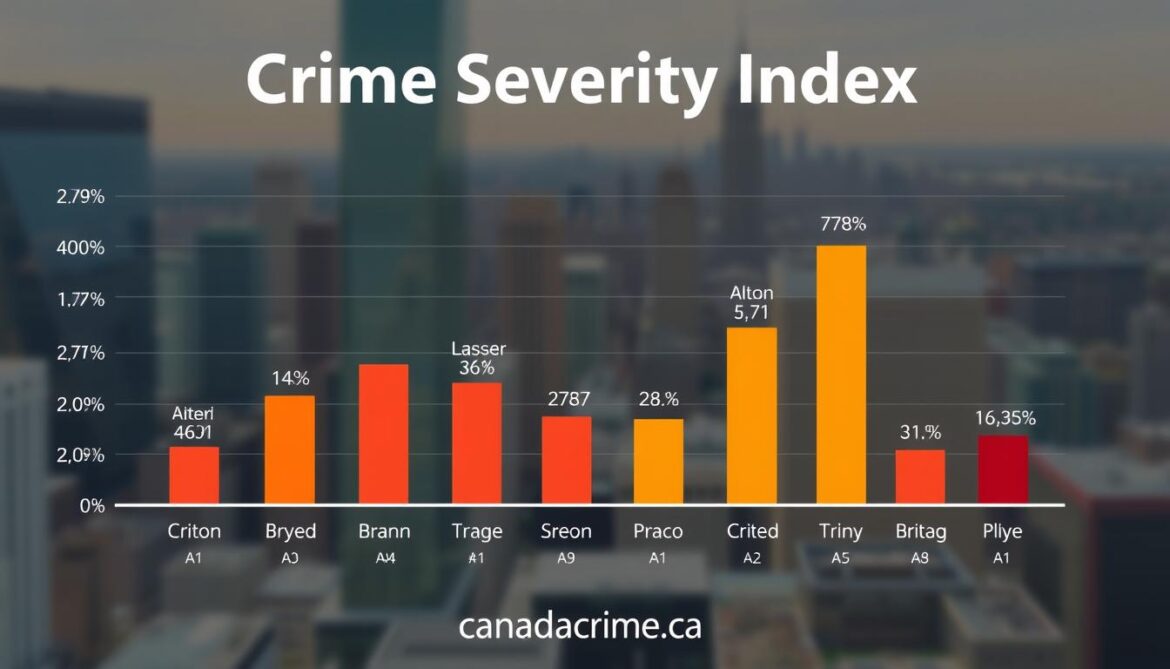Did you know that Red Deer, Alberta, tops the list with a Crime Severity Index (CSI) of 176.4, making it the city with the most significant crime concerns in Canada? This alarming statistic highlights the need to understand the factors contributing to elevated crime rates in major Canadian cities.
Recent statistics from Statistics Canada provide valuable insights into the crime information across different municipalities, shedding light on the cities that require attention and policy intervention.
The Crime Severity Index is a crucial metric used to measure and compare crime rates across various cities, taking into account both the volume and severity of crimes. By examining the CSI and other crime data, we can gain a deeper understanding of the complex issues surrounding crime in Canada.
Understanding Crime Measurement in Canada
Understanding crime rates in Canada requires a deep dive into the methodologies used to track and measure crime, including the Crime Severity Index (CSI). The CSI is a critical tool in assessing the crime situation across different regions in Canada.
Crime Severity Index (CSI) Methodology
The Crime Severity Index (CSI) is Canada’s primary method for measuring crime, taking into account both the volume and seriousness of crimes. It weighs offenses based on their severity as determined by court sentencing practices. This approach ensures that more serious crimes, such as homicide, are given greater weight than less serious offenses like property theft.
Difference Between Violent and Non-Violent Crime Statistics
Violent crime statistics track offenses against persons, including homicide, assault, sexual assault, and robbery. In contrast, non-violent crime encompasses property crimes and other offenses that don’t involve violence against individuals. Understanding the distinction between these two categories is essential for developing effective crime prevention strategies.
How Canadian Cities Compare to International Crime Rates
When comparing Canadian cities to international counterparts, it’s crucial to consider the varying methodologies used to track crime. Canadian cities generally have lower homicide rates than many cities in the United States, Mexico, and Brazil. For instance, Canadian homicide rates are typically 3-5 times lower than those in the United States.
| City | Crime Rate per 100,000 | Homicide Rate per 100,000 |
|---|---|---|
| Toronto, Canada | 3,964.1 | 1.67 |
| New York City, USA | 5,506.6 | 3.4 |
| Mexico City, Mexico | 7,846.2 | 4.6 |
Crime data is typically reported per 100,000 population to allow for meaningful comparisons between cities of different sizes. This standardized approach facilitates a more accurate understanding of crime rates across various jurisdictions.

Cities with the Highest Crime Rate per City in Canada
Crime rates in Canada are not uniform, with certain cities facing significant challenges related to both violent and non-violent crimes. The Crime Severity Index (CSI) is a crucial metric for understanding the crime landscape across different Canadian cities.

Red Deer, Alberta
Red Deer, Alberta, tops the list with a CSI of 176.4, making it Canada’s most dangerous city. Despite a significant decrease in property crimes, the city experiences high rates of both violent and property crimes. The Red Deer RCMP’s Quarterly Community Policing Report highlights a slight increase in persons crimes, indicating a complex crime profile.
Kelowna, British Columbia
Kelowna follows closely with a CSI of 141.9. Notably, non-violent crimes are significantly higher than violent crimes, challenging the common perception of this tourist destination. The city’s crime profile suggests a need for targeted interventions to address specific types of criminal activity.
Saskatoon, Saskatchewan
Saskatoon, with a CSI of 125.7, has seen concerning trends, including a 65.6% increase in interactions between fire crews and inadequately housed individuals between 2022 and 2023. This trend highlights the interconnectedness of housing insecurity and crime rates.
Winnipeg, Manitoba
Winnipeg recorded the largest jump in crime severity among major Canadian cities, with a 20% increase from 2021 to 2022. This significant rise outpaced national trends, underscoring the need for localized crime prevention strategies.
Regina, Saskatchewan
Regina, with a CSI of 116.3, faces persistent challenges with violent offenses, having the third-highest violent crime CSI in Canada. Despite various intervention programs, the city continues to struggle with violent crime.
Other Notable High-Crime Canadian Cities
Other cities, including Edmonton (Alberta), Surrey (British Columbia), and Greater Sudbury (Ontario), also experience concerning crime rates, each with unique patterns of criminal activity. Common challenges among these cities include substance abuse issues, housing insecurity, and socioeconomic disparities.
Understanding the specific crime profiles of these cities is essential for developing targeted intervention strategies that address the root causes of criminal behavior in each community.
Canadian Criminal Code and Crime Classification
The Criminal Code of Canada is the primary legislation that governs criminal law, outlining various offenses and their corresponding penalties. It is the cornerstone of Canada’s criminal justice system, providing a framework for understanding and addressing crime across the country.
Structure and Organization
The Canadian Criminal Code is structured to categorize offenses based on their severity and social impact. First established in 1892, it has undergone numerous updates to reflect changing societal values and legal perspectives. The Code classifies crimes into indictable offenses (more serious crimes tried in superior courts), summary conviction offenses (less serious crimes tried in provincial courts), and hybrid offenses (where the Crown can choose the procedure).
Major Crime Categories
Crimes in Canada are categorized into several major groups, including:
- Crimes against the person (homicide, assault, sexual offenses)
- Property crimes (theft, fraud, mischief)
- Public order offenses
- Controlled substance violations
Each category has specific elements and sentencing guidelines, ensuring a standardized approach to crime classification and prosecution.

Reporting and Tracking Crimes
The national crime reporting system in Canada relies on the Uniform Crime Reporting Survey, where police services across the country submit standardized data to Statistics Canada for analysis and publication. This system ensures that crime data is collected and analyzed consistently, providing a clear picture of crime trends nationwide.
Recent Changes
Recent amendments to the Criminal Code have addressed emerging issues such as cybercrime, intimate partner violence, and drug offenses. These updates reflect evolving social concerns and legal perspectives, ensuring that the Canadian criminal justice system remains relevant and effective.
Understanding the structure and organization of the Criminal Code is essential for contextualizing crime statistics and gaining insight into how different offenses are categorized and prosecuted within the Canadian legal system. The classification system directly impacts how crimes are counted in statistical analyses, which in turn affects the Crime Severity Index calculations for different municipalities.
Detailed Crime Information by City
A closer look at crime statistics in major Canadian cities shows diverse trends in criminal activity. Understanding these patterns is crucial for developing effective crime prevention strategies.
Violent Crime Hotspots
Violent crime hotspots in Canada show distinct regional patterns. The Prairie provinces generally experience higher rates of violent offenses compared to other regions. For instance, Winnipeg recorded 54 homicides in 2022, with a rate of 7.20 per 100,000 people.

Property Crime Trends
Property crime trends vary across Canadian cities. British Columbia cities like Kelowna and Vancouver experience high rates of theft, break-and-enter offenses, and auto theft. This highlights the need for targeted law enforcement strategies in these areas.
Drug-Related Offenses
Drug-related offenses follow distinct regional patterns. Opioid-related crimes are more prevalent in western provinces, while stimulant-related offenses are more common in central Canada. The relationship between drug offenses and other crimes is particularly strong in cities like Vancouver.
Homicide Rates
Homicide rates in Canadian urban centers vary significantly. Thunder Bay had 15 homicides in 2022, with a rate of 13.78 per 100,000, making it one of the highest per capita in Canada. In contrast, Montreal had a homicide rate of 2.32 per 100,000.
| City | Homicide Rate per 100,000 | Number of Homicides |
|---|---|---|
| Thunder Bay | 13.78 | 15 |
| Winnipeg | 7.20 | 54 |
| Toronto | 3.04 | 85 |
| Montreal | 2.32 | 41 |
Understanding these detailed crime patterns helps law enforcement agencies allocate resources effectively and develop targeted intervention strategies for specific types of criminal activity in different urban environments.
Factors Behind High Crime Rates in Canadian Cities
The prevalence of crime in Canadian cities can be attributed to a complex interplay of socioeconomic and environmental factors. Understanding these underlying causes is essential for developing effective strategies to reduce crime rates.
Socioeconomic Disparities and Crime Correlation
Socioeconomic disparities play a significant role in determining crime rates across Canadian cities. Neighborhoods with higher poverty levels tend to record more criminal incidents per capita. Moreover, income inequality is a stronger predictor of crime rates than absolute poverty levels, explaining why some relatively affluent cities still experience significant crime challenges in specific areas.
Housing Insecurity and Homelessness Impact
Housing insecurity and homelessness have a direct correlation with crime rates. For instance, Saskatoon saw a 65.6% increase in interactions between fire crews and inadequately housed individuals between 2022 and 2023, coinciding with rising crime rates. The concentration of social services in specific neighborhoods sometimes inadvertently creates “hotspots” for criminal activity.

Substance Abuse and Mental Health Challenges
The relationship between substance abuse and crime is particularly evident in cities like Vancouver and Winnipeg. Overdose incidents have increased dramatically, with Saskatoon’s fire department calls for overdoses rising from 289 in 2019 to 1,395 in 2023. Mental health challenges intersect with both substance abuse and criminal behavior, creating complex situations that traditional law enforcement approaches struggle to address.
Law Enforcement Resources and Response Times
Police resource allocation and response times vary significantly across Canadian municipalities. High-crime areas often experience longer wait times for emergency services due to high call volumes and staffing limitations. Understanding these factors is crucial for developing effective crime reduction strategies.
Crime Prevention Strategies and Initiatives
Effective crime prevention in Canada involves a combination of community programs, municipal initiatives, and federal policies. These strategies work together to address the root causes of crime and enhance public safety across the country.
Community-Based Prevention Programs
Community-based prevention programs have shown significant success in reducing crime rates. For instance, in Red Deer, property crimes decreased by 27.8% over two years through targeted community policing initiatives. Successful community approaches include neighborhood watch programs, youth mentorship initiatives, and community policing strategies that build trust between residents and law enforcement.
Municipal Safety Initiatives in High-Risk Areas
Municipal safety initiatives in high-risk areas often combine increased police presence with environmental design modifications. Improvements such as better lighting, security cameras, and the elimination of isolated areas where crimes frequently occur are common. The “broken windows” theory has influenced many Canadian municipal strategies, focusing on addressing minor disorders and property maintenance to prevent escalation to more serious criminal activity.
Federal and Provincial Crime Reduction Policies
Federal and provincial policies increasingly emphasize rehabilitation and diversion programs for non-violent offenders, particularly those with substance abuse or mental health challenges. The federal government’s National Crime Prevention Strategy provides funding for evidence-based initiatives targeting at-risk populations, with a particular emphasis on youth intervention programs.
Personal Safety Recommendations for Residents and Visitors
Personal safety recommendations for residents and visitors include staying aware of surroundings, avoiding isolated areas after dark, securing valuables, and knowing emergency contact information for local authorities. Technology plays an increasing role in crime prevention, with many cities implementing smart surveillance systems, emergency alert applications, and online crime mapping tools to help residents make informed decisions about personal safety.
| Crime Prevention Strategy | Description | Impact |
|---|---|---|
| Community-Based Programs | Neighborhood watch, youth mentorship, community policing | Reduced property crimes by 27.8% in Red Deer |
| Municipal Safety Initiatives | Increased police presence, environmental design modifications | Enhanced public safety in high-risk areas |
| Federal and Provincial Policies | Rehabilitation and diversion programs for non-violent offenders | Reduced recidivism rates among targeted populations |

Conclusion: Addressing Canada’s Urban Crime Challenges
The issue of urban crime in Canada demands a multifaceted approach to address both immediate safety concerns and underlying socioeconomic factors that contribute to criminal behavior. While cities like Red Deer, Kelowna, and Saskatoon face significant crime challenges, it’s essential to recognize that Canada maintains lower crime rates than many comparable countries, particularly regarding violent offenses.
The contrast between high-crime cities and the safest municipalities, such as Halton Region (CSI:24.0) and Terrebonne (CSI:28.9), demonstrates that effective governance and community engagement can significantly impact public safety outcomes. Future crime prevention strategies will likely emphasize integrated approaches that combine law enforcement, social services, healthcare, education, and community development.
Data-driven approaches to crime prevention and resource allocation are becoming increasingly important. By understanding the factors behind crime rate variations across Canadian cities, policymakers can develop more effective, targeted approaches to enhancing public safety while addressing the underlying causes of criminal behavior, including the complex relationship between substance abuse, mental health, and crime.

